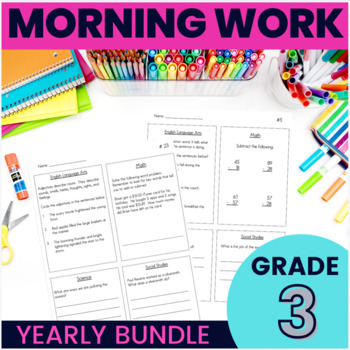3rd Grade Morning Work Bundle: 180 days (Math, Science, Socials Studies and ELA)
- Zip
What educators are saying
Products in this Bundle (4)
Description
Are you looking to make your morning work meaningful? This 3rd Grade Morning Work Bundle provides 180 spiral reviews with ample practice to allow students successful mastery of important 3rd Grade standards. Each day contains ELA, Math, Science, and Social Studies practice aligned with Common Core Standards. Save 25% with purchasing the entire year!
Grab the free sample HERE.
Graphs are provided for easy use for parent conferences, intervention meetings, student self-assessment, and teacher assessment.
Each subject has an end-of-quarter review quiz for students to demonstrate what they have learned.
The science and social studies sections are great for student research skills. Students can use resources (encyclopedia, internet, textbooks, etc.) to find the answers they don’t know from memory. Finding and using information is an important standard for the 21st Century Learner.
The 1st and 2nd Quarter assessments review and introduce new standards. The 3rd Quarter introduces new standards, as well as, reviews the standards to prepare for standardized testing. The 4th quarter extends the standards and introduces new skills that will prepare students for fourth grade.
This is a zip file. Be sure your computer can download zip files before purchasing.
Don’t Need the Entire Year? Try these:
Morning Work - Grade 3 - Quarter 1
Morning Work - Grade 3 - Quarter 2
Morning Work - Grade 3 - Quarter 3
Morning Work - Grade 3 - Quarter 4
Quarter 1 Standards:
ELA
Parts of Speech (Nouns, Verbs, Adjectives, Adverbs, and Pronouns)
Subject and Predicate
Superlatives
Math:
Addition and subtraction with and without zeros
Word problems using addition and subtraction
Adding and subtracting money
Place Value
Expanded Form
Word Form
Comparing Numbers
Ordering Numbers
2D shapes
Science:
Ecosystems
Habitats
Producers
Consumers
Adaptations
Pollution
Rocks and Minerals
Soils
Social Studies:
Democracy
Branches and levels of government
Leaders
Informational Resources
Paul Revere
Susan B. Anthony
Frederick Douglass
Franklin D. Roosevelt
Quarter 2 Standards
ELA:
Types of Sentences
Verb Tenses
Irregular Verbs
Using Capitals
Commas
Editing
Interjections
Conjunctions
Main Idea
Supporting Details
Math:
Shape Attributes
Fractions
Perimeter
Area
Review
Science:
Fossils
Sound
Heat
Social Studies:
Thurgood Marshall
Lyndon B. Johnson
Civil Rights
Citizen Rights
Economy
Quarter 3 Standards
ELA:
Comparative adjectives
Fiction genres
Nonfiction
Character Traits
Setting
Context Clues
Possessives
Quotation Marks
Figurative Language (literal and nonliteral language)
Comparing and contrasting stories
How illustrations enhance understanding
Poetry (lines, stanzas, and rhyme schemes)
Math:
Multiplication Facts
Division Facts
Multiplying and Dividing by 10, 100, and 1,000
Multiplying 2-digit by 2-digit numbers (regular and lattice method)
Multiplying 3-digit by 2-digit numbers (regular and lattice method)
Science:
Weather
Light
Health
Testing Review
Social Studies:
Major US Landforms (Rivers and Mountains)
Climates
Compass Rose
Mary McLeod Bethune
Testing Review
Quarter 4 Standards
ELA:
Mood
Theme
Text Features
Prefixes
Suffixes
Root Words
Using a Dictionary
Using a Thesaurus
Homophones
Synonyms
Antonyms
Asking and answering questions about a text
Math:
Division
Measurement
Word Problems
Place Value to Billions
Review
Science:
Space
Electricity
Introduce 4th Grade skills
Social Studies:
Native Americans
American Revolution
Civil War





